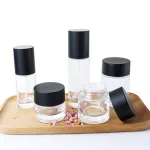Different uses of cosmetic glass bottles
Cosmetic glass bottles are an important part of cosmetic packaging. In addition to its product efficacy, the sales of cosmetics, whether the design can attract consumers' attention is also crucial. However, many cosmetics brands have little knowledge about packaging materials when choosing product packaging. How to make their products catch the attention of customers undoubtedly requires the selection of appropriate packaging materials and designs.
Advantages of cosmetic glass bottles
Among cosmetic packaging materials, glass bottles are increasingly recognized by the market due to their characteristics. This is mainly because using glass bottles has the following benefits:
1. The glass material is lead-free and harmless, and has good barrier properties. It can well prevent various gases from oxidizing and corroding the objects inside the bottle, and at the same time, it can effectively prevent the volatilization of volatile components of the objects inside.
2. Glass bottles can be recycled and used multiple times, which reduces packaging costs for enterprises and is also beneficial to environmental protection.
3. The glass is transparent and the interior material texture is clearly visible. The "appearance + effect" conveys a high-quality feeling to consumers.
4. Glass bottles are safe and hygienic, non-toxic, have good corrosion resistance and acid corrosion resistance, and have special packaging advantages for the cosmetics industry.

There are many types of glass bottles and jars. According to the usage, they can be divided into recycled bottles and non-recyclable bottles (disposable bottles); according to the manufacturing method, they can be divided into molded bottles (bottles and jars formed with models) and controlled bottles. Bottles (bottles made of glass tubes) are divided into food packaging bottles, medicine bottles, cosmetic bottles, cultural and educational bottles, etc. But they can generally be classified into two categories: thin-neck bottles (small-mouth bottles) and thick-neck bottles (large-mouth bottles).Application of cosmetic glass bottles in cosmetics (cream bottles, essences, toners, essential oil bottles)
Glass bottles used in cosmetics are mainly divided into several categories: skin care products (creams, lotions), foundation, perfume, essential oils, and nail polish. Those with a capacity greater than 200ml are rarely used in cosmetics.
Glass bottles are divided into wide-mouth bottles and narrow-mouth bottles.
Solid pastes generally use wide-mouth bottles, which should be equipped with electric aluminum caps or plastic caps. The bottle caps can be used for color spraying and other effects, such as cream bottles, facial mask bottles and other commonly used jars;
Emulsions or aqueous pastes generally use narrow-mouth bottles, and should be equipped with a pump head. If equipped with a lid, an inner plug is required to prevent leakage. Aqueous liquids are equipped with a small hole inner plug, and thicker emulsions are equipped with a large hole inner plug. .
Essential oil bottles are usually brown or colored frosted to protect them from light. The lids have safety rings and can be equipped with inner stoppers or droppers. Perfume bottles are usually equipped with delicate spray pump heads or plastic lids.


